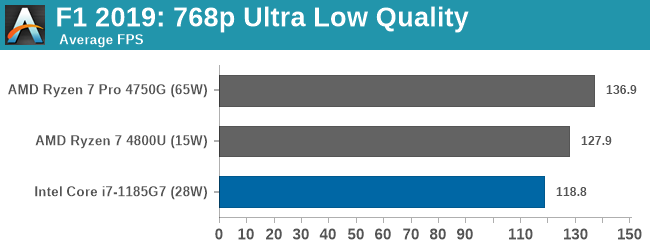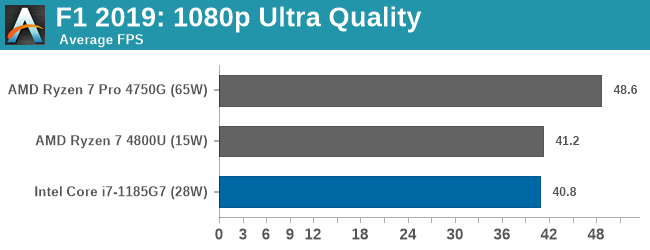Intel’s Tiger Lake 11th Gen Core i7-1185G7 Review and Deep Dive: Baskin’ for the Exotic
by Dr. Ian Cutress & Andrei Frumusanu on September 17, 2020 9:35 AM EST- Posted in
- CPUs
- Intel
- 10nm
- Tiger Lake
- Xe-LP
- Willow Cove
- SuperFin
- 11th Gen
- i7-1185G7
- Tiger King
Xe-LP GPU Performance: F1 2019
The F1 racing games from Codemasters have been popular benchmarks in the tech community, mostly for ease-of-use and that they seem to take advantage of any area of a machine that might be better than another. The 2019 edition of the game features all 21 circuits on the calendar, and includes a range of retro models and DLC focusing on the careers of Alain Prost and Ayrton Senna. Built on the EGO Engine 3.0, the game has been criticized similarly to most annual sports games, by not offering enough season-to-season graphical fidelity updates to make investing in the latest title worth it, however the 2019 edition revamps up the Career mode, with features such as in-season driver swaps coming into the mix. The quality of the graphics this time around is also superb, even at 4K low or 1080p Ultra.
To be honest, F1 benchmarking has been up and down in any given year. Since at least 2014, the benchmark has revolved around a ‘test file’, which allows you to set what track you want, which driver to control, what weather you want, and which cars are in the field. In previous years I’ve always enjoyed putting the benchmark in the wet at Spa-Francorchamps, starting the fastest car at the back with a field of 19 Vitantonio Liuzzis on a 2-lap race and watching sparks fly. In some years, the test file hasn’t worked properly, with the track not being able to be changed.
For our test, we put Alex Albon in the Red Bull in position #20, for a dry two-lap race around Austin.


In this case, at 1080p Ultra, AMD and Intel (28W) are matched. Unfortunately looking through the data, the 15 W test run crashed and we only noticed after we returned the system.











253 Comments
View All Comments
tipoo - Friday, September 18, 2020 - link
Sounds like their next Macbook releases are going to be Apple Silicon, not sure we'll ever see a TGL Apple system.AMDSuperFan - Thursday, September 17, 2020 - link
What worries me the most is that this Tiger is better than Renoir in every way possible. I feel like Intel is the Apple of laptops now and our AMD are some knockoff tablet with good specs but not up to snuff. This 4 core beating the 8 core Renoir is terrible. I know we have Big Navi coming and that should save us here, but right now the Nvidia and Intel products are really bad for us fans.Spunjji - Friday, September 18, 2020 - link
I worry about the mental health of the person running this account.eddman - Thursday, September 17, 2020 - link
Why intel didn't do 6-8 core low power models again? 10nm too power hungry? Low yields and/or low manufacturing capacity?Spunjji - Thursday, September 17, 2020 - link
Yes!But seriously, all of the above.
eek2121 - Thursday, September 17, 2020 - link
Fab capacity.RedOnlyFan - Friday, September 18, 2020 - link
Hahaha. Fake informationSpunjji - Friday, September 18, 2020 - link
What's your explanation then, Red? "They didn't want to"?They compete well with AMD at 15W but need 28W to get full performance from the design. Squeezing twice as many cores in would push them way, way off the bottom of their efficiency curve. They're running more complex cores than AMD and they require more power, no way around that.
If yields were good enough they'd have had 8-core Ice Lake designs out taking the fight back to AMD on the desktop, but mysteriously they skipped those and rehashed Skylake again. It's almost like something was holding them back...
JayNor - Thursday, September 17, 2020 - link
Intel chose to integrate high performance wifi6, thunderbolt 4, avx512, dlboost, pcie4 features rather than the more small hammers approach.Alder Lake will have even smaller and lower power cores than AMD's, so perhaps next year the choice for Cinebench processing will get funny.
RSAUser - Thursday, September 17, 2020 - link
You mentioned this again, so I'll comment again:WiFi 6/802.11ax: AMD does not do networking equipment, it's also not part of the CPU, it's an
extra module attached to the mobo.
PCIe 4: No benefit in laptops, there's no SSD that can really max it out consumer side and GPU wise. PCIe 4 consumes a lot more power than 3rd gen.
Thunderbolt 4: You actually mean USB 4.
AVX512: Not many things actually use this, a majority of those use-cases can just go GPU, and you're not really running an AVX512 workload on a laptop.
DLBoost: Intel's ML library, you're not training ML libraries on a laptop CPU, you'd near always want to use a GPU instead, plus that specific one is Intel's trademark one, you'd use open source alternatives.
AMDs' leaked roadmaps are USB 4 and PCIe 4 in 2022, and here you didn't mention LPDDR5, which is also included in that release.